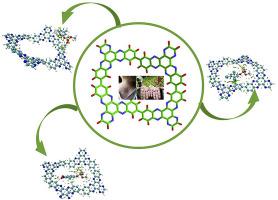Journal of Physics and Chemistry of Solids ( IF 4.3 ) Pub Date : 2021-08-18 , DOI: 10.1016/j.jpcs.2021.110345 Misbah Asif 1 , Hasnain Sajid 2 , Khurshid Ayub 1 , Muhammad Ans 3 , Tariq Mahmood 1

|
C4N is a novel porous two-dimensional material with fascinating electronic and chemical properties. Thereby, the sensing ability of C4N is the most aspect topic of research nowadays. In this study, potential application of C4N nanoflake as a chemical sensor for the toxic pesticides has been investigated using density functional theory calculations. The sensing ability of C4N for pesticides is evaluated through the interaction energy, noncovalent interaction index (NCI), quantum theory of atoms in molecule (QTAIM), molecular orbitals and CHELPG charge transfer analyses. The first principle calculations on ωB97XD/6-31G(d, p) level of DFT show that the C4N is selectively sensitive to Dichlorodiphenyltrichloroethane (DDT), Fenitrothion (FNT), Dimethoxy (DMDT), Ronnel (RN) and Fenthion (FT). The interaction of pesticides leads to the significant changes in the electronic structure of C4N. The observed sequence of interaction energy of our reported complexes is DDT@C4N > FNT@C4N > DMDT@C4N > RN@C4N > FT@C4N. The electronic structure changes can be demonstrated from two aspects: the strong interaction between pesticide molecule and C4N, the variation in HOMO-LUMO orbital energies and charge transfer from C4N to pesticide. The charges distribution between analytes and C4N nanoflake on interaction is analyzed by the electron density differences (EDD) and charge decomposition analysis (CDA). Our results reveal the potential application of C4N in electronic and sensor devices especially for the detection of toxic chemicals.
中文翻译:

多孔C4N纳米片电化学传感剧毒农药的第一性原理研究
C 4 N 是一种新型多孔二维材料,具有迷人的电子和化学性质。因此,C 4 N的传感能力是当今研究最多的课题。在这项研究中,使用密度泛函理论计算研究了 C 4 N 纳米薄片作为有毒农药化学传感器的潜在应用。通过相互作用能、非共价相互作用指数(NCI)、分子中原子的量子理论(QTAIM)、分子轨道和CHELPG电荷转移分析来评估C 4 N对农药的传感能力。在 DFT 的 ωB97XD/6-31G(d, p) 水平上的第一原理计算表明,C 4N 对二氯二苯基三氯乙烷 (DDT)、硝基硫磷 (FNT)、二甲氧基 (DMDT)、Ronnel (RN) 和倍硫磷 (FT) 具有选择性敏感。农药的相互作用导致C 4 N的电子结构发生显着变化。我们报道的配合物观察到的相互作用能顺序为DDT@C 4 N > FNT@C 4 N > DMDT@C 4 N > RN@C 4 N > FT@C 4 N。可以从两个方面证明电子结构的变化:农药分子与C 4 N之间的强相互作用、HOMO-LUMO 轨道能量的变化以及C 4 N 到农药的电荷转移。分析物与 C 4之间的电荷分布通过电子密度差异 (EDD) 和电荷分解分析 (CDA) 分析 N 纳米薄片的相互作用。我们的结果揭示了 C 4 N 在电子和传感器设备中的潜在应用,特别是用于检测有毒化学品。











































 京公网安备 11010802027423号
京公网安备 11010802027423号